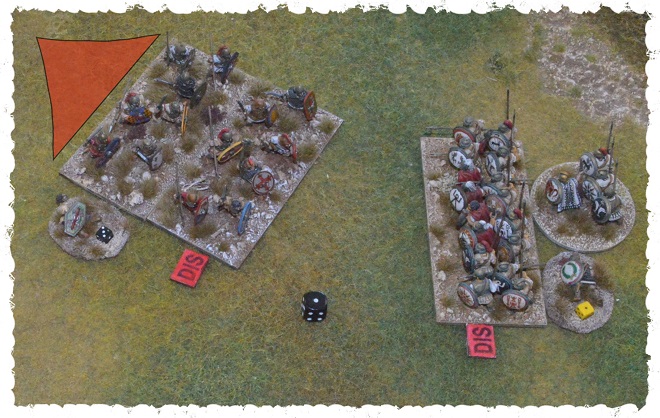The following narrative walks you through a confrontation between a large unit of Celtic warriors and a single element of Libyan heavy infantry. There are two melees in this example. The first is a result of the Celts charging in to contact while the second is caused by the resulting pursuit. Both players participate in a melee potentially causing damage to their opponent’s unit. There is really only two basic steps to melee in Impetus. 1: Score hits by rolling a set number of combat dice. 2: Convert these hits into permanent losses via a cohesion test. For clarity I have broken these steps into smaller parts to hopefully explain things in a little more detail.
1: Declare & move charge.
The general controlling a large element of Celt warriors has won the initiative. He declares a charge against the Libyan spear-men. As the Celts are within the frontal arc of their target the Libyans could try to react to the charge. By successfully passing a discipline test they could mount a counter charge. However, in this example the spear-men have decided to stand in place so no test is necessary. In Impetus there is no lining up or conforming after units come in to contact. Units or groups simply move in to base to base contact and then fight.

2: Calculate Combat Dice.
The veteran Celts have a VBU value of 5. They are a large unit (+1) and receive an Impetus bonus for charging (+2). This gives them a total of 8 combat dice.
The Libyans also have a VBU value of 5. Their discipline class is one step higher than the Celts (+1) and their general is attached (+1). That makes a total of 7 combat dice.
VBU is a unit’s offensive and defensive value all rolled into one factor.
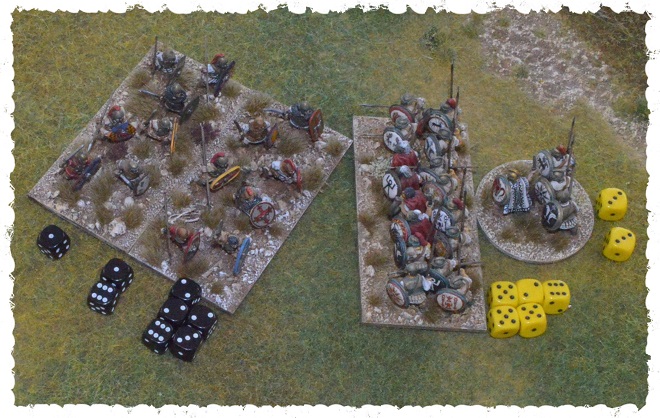
3: Roll Attacks
A pair of fives or a single six is what’s required to hit your opponent no matter the mode of attack in this game. The harder it is to hit someone the less dice you will be rolling. Here, the Celts (black dice) have managed to roll fives on three of their eight combat dice. This only equates to a single hit as they would need one extra five to score two hits. The Libyans have fared a little better rolling a single six and a pair of fives with their yellow dice. Giving them a total of two hits on the Celts.
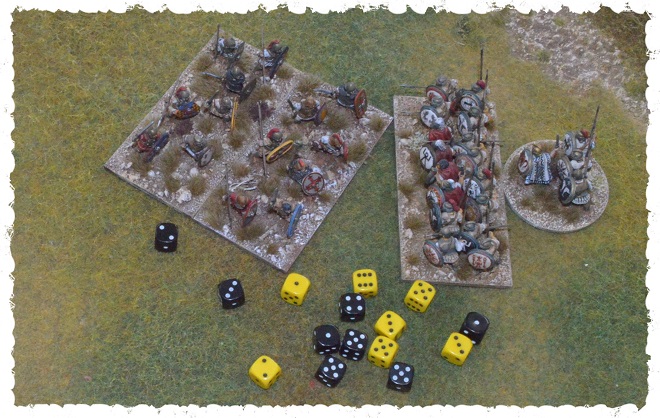
4: Test Unit Cohesion.
Every time an element takes damage it must check for permanent losses via a cohesion test. In this example both units have been hit so each must now make a cohesion test.
The Celts have a VBU value of five and have taken two hits. At this stage there are no other modifiers to consider (5-2=3). This is their critical number. Permanent losses to a unit are decided by subtracting the critical number from a single dice roll. Unfortunately, the Celts have rolled a four (4-3=1).
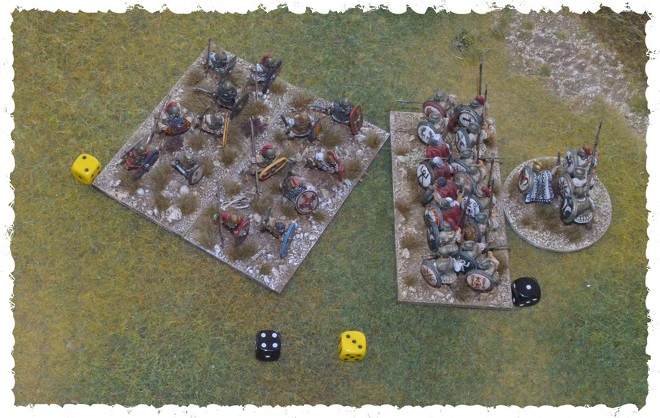
So they receive, one permanent loss to the rear element in their formation. The Libyans also have a VBU value of five and have received just one hit from the Celts in the melee. The attached general also adds a single positive modifier to their total (5-1+1=5). Thus, with a critical number of five and a cohesion dice roll of three they take no permanent losses this round (3-5=0 or less). Both units are now marked as disordered as they both took hits in the proceeding melee.
5: Retreat & Pursuit Rolls
The losing unit must now fallback out of combat by rolling a single dice on the retreat table. Rolling a one the Celts can only fallback one unit of movement (1H). After the Celts have completed their retreat move the Libyans may try to pursue them. Rolling a four the heavy infantry gain just enough movement to catch the Celts and restart the melee.
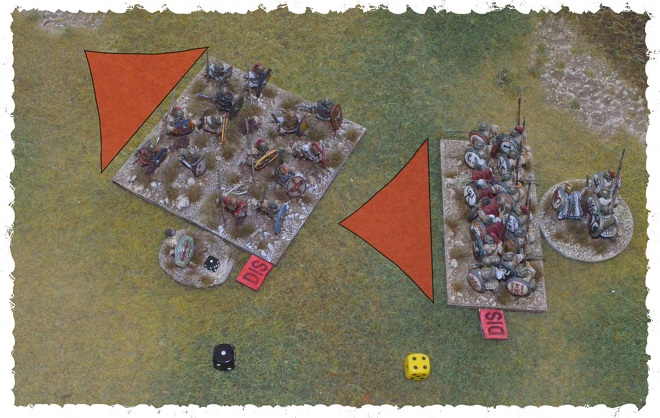
2nd Round: Combat Dice
This time the Libyans are classed as charging. VBU (5), disordered (-1), Impetus bonus (+2), better discipline class (+1) and attached general (+1). Eight combat dice.
While the Celts get decidedly less. VBU (5), disordered (-1) and large unit (+1). Just five dice this time.
Note: Casualties usually lower your VBU and therefore your combat dice. But, because the Celts are a large unit this will not come into play until the rear element is remove though losses.
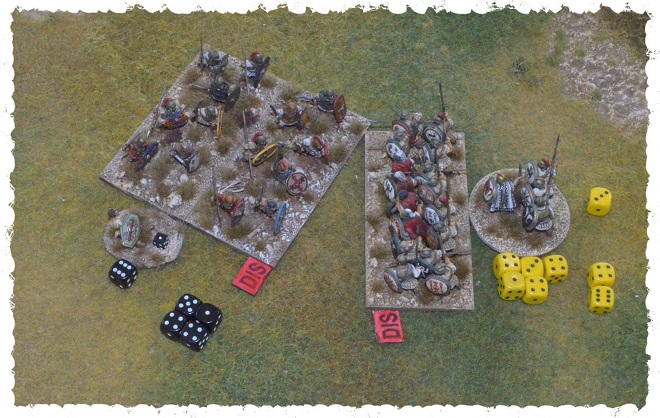
3: Roll Attacks
Three hits for the Heavy infantry with the yellow dice and two in return from the Celts
.
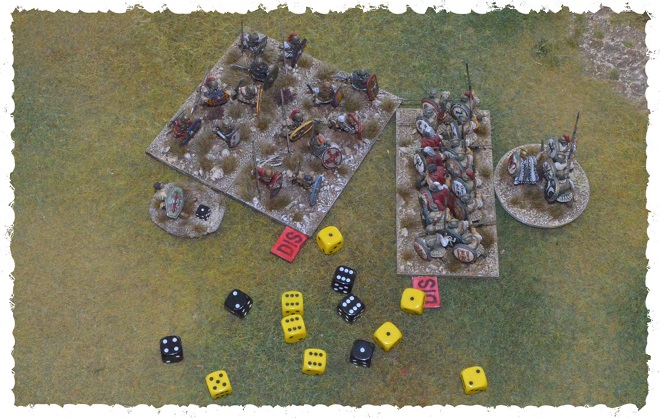
4: Final Cohesion Tests.
The Libyans start with their VBU (5), disordered (-1), damage taken (-2) and attached general (+1). This gives the heavy infantry unit a critical number of three (5-1-2+1=3). Rolling a four on the cohesion test they receive one permanent loss (4-3=1).
The Celts also start with their VBU at full strength (5), disordered (-1), damage taken (-3) leaving them with a critical number of just one. Scoring three on their cohesion test they gain two more casualties (3-1=2). Beaten for the second time the Celts must roll again on the retreat table.
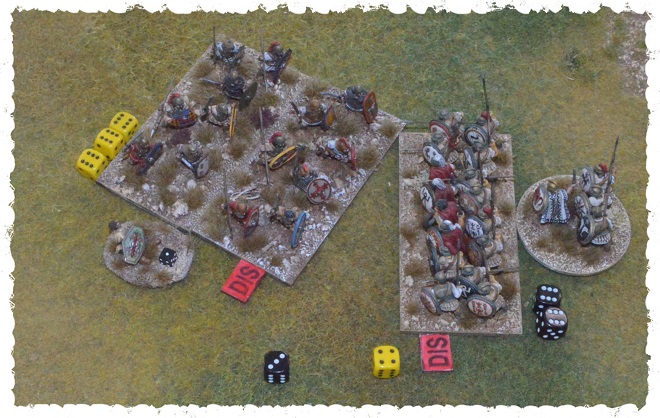
5: Final Retreat Move
Rolling low on the retreat table again the Celts retire just 1H (movement unit). There is only one pursuit phase after a melee, so the Libyans must remain stationary until it is their turn to activate. The Celtic general is now free to active any remaining units in his command. If he has already done so a new initiative round is diced for.
